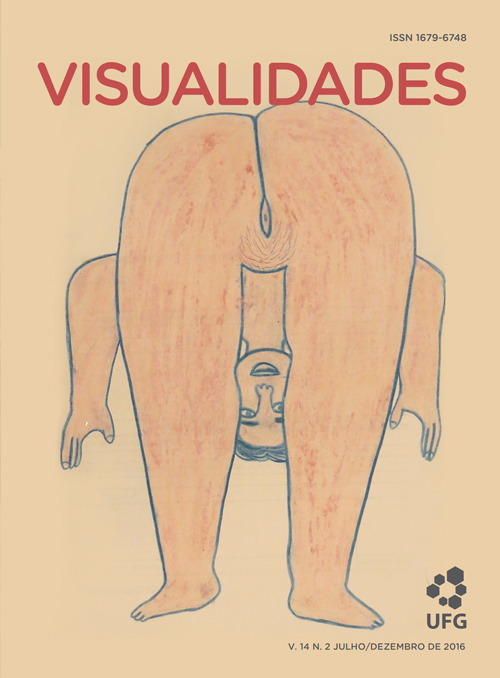Flowers, colors and shapes: Brazil stamped in chita
DOI:
https://doi.org/10.5216/vis.v14i2.39636Abstract
At work, the relation between art and culture is examined by means of the analysis of chita appropriations, a cloth that characterizes the Brazilian culture, in the creation of visualities in a book for the children segment: “A party of colors: memories of a Brazilian cloth”, by Anna Gobel and Ronaldo Fraga (2004, our translation). From the visual production found in the book, we aimed to identify how the visual elements communicate Brazilian characteristics with the readers, from story and appropriation of cloth in the narrative told in the book.
Keywords: Chita, culture, image
Downloads
References
ANDRADE, Mário. Danças dramáticas. Belo Horizonte: Itatiaia, 1982.
ARNHEIM, Rudolf. Arte e percepção visual: uma psicologia da visão criadora. Nova versão: São Paulo, 2006.
BARBOSA, Ana Mae. Inquietações e mudanças no ensino da arte. São Paulo: Cortez, 2008.
BOUDIEU, Pierre. A distinção: Crítica social do julgamento. Porto Alegre: Zouk, 2007.
CANCLINI, Néstor Garcia. As Culturas Populares no Capitalismo. São Paulo: Brasiliense, 1998.
CANCLINI, Néstor García. Culturas Híbridas: estratégias para entrar e sair da modernidade. São Paulo: EDUSP, 2011.
CASCUDO, Luís da Câmara. Dicionário do Folclore Brasileiro. 8. ed. São Paulo: Global, 1980.
CASTANHA, Marilda. A linguagem visual no livro sem texto. In: OLIVEIRA, Ieda de. (Org). O que é qualidade em ilustração no livro infantil e juvenil: com a palavra o Ilustrador. São Paulo: Editora DCL, 2008. p. 140- 151.
CHATAIGNIER, Gilda. Fio a fio. Tecidos, moda e linguagem. SP: Estação das letras e cores, 2006.
CHATAIGNIER, Gilda. História da Moda no Brasil. São Paulo: Estação da Letras e Cores, 2010.
DELEUZE, Gilles. Conversações. São Paulo: Editora 34, 1999.
FELDMAN, Edmund Burke. Metodologia de trabalho. São Paulo: USP, 1993.
FITTIPALD, Ciça. O que é uma imagem narrativa. In: OLIVEIRA, Ieda de. (Org). O que é qualidade em ilustração no livro infantil e juvenil: com a palavra o Ilustrador. São Paulo: Editora DCL, 2008. p. 93- 123.
GOBEL, Anna; FRAGA, Ronaldo. Uma festa de cores: Memórias de um tecido brasileiro. Belo horizonte: Editora Autêntica, 2014.
GOMES, Paola. A formação de visualidade, imaginário e estereótipos. Revista da Fundarte, Ano II, vol. II, n° 4, jul 2002/ dez 2002.
HALL, Stuart. A identidade cultural na pós-modernidade. Rio de Janeiro: DP&A, 2006.
KERBER, Alessander. Carmen Miranda: Entre representações da identidade nacional e de identidades regionais. Revista Artcultura: Uberlândia, v. 7, n° 10, p. 121-132, jan/jun 2005.
MAIA, Antônio Cavalcanti. Diversidade cultural, identidade nacional brasileira e patriotismo constitucional. Disponível em: http://www.casaruibarbosa.gov.br/dados/DOC/palestras/Diversidade_Cultural/FCRB_DiversidadeCulturalBrasileira_AntonioCavalcanti.pdf. Acesso em: Set. 2015
MELLÃO, Renata; IMBROSI, Renato. Que chita bacana. São Paulo: Editora A Casa, Museu do Objeto brasileiro, 2005.
MOURA, Regina. Sobre a indumentária na festa popular: imagens, signos e fantasias. Textos escolhidos de cultura e arte populares, Rio de Janeiro, v.7, n.1, p. 101-108, mai. 2010.
NEIRA, Luz Garcia. Estampas na tecelagem brasileira: Da origem à originalidade. Tese de doutorado em Arquitetura - Faculdade de Arquitetura da Universidade de São Paulo, 2012.
ORTIZ, Renato. Cultura brasileira e identidade nacional. São Paulo: Brasiliense, 1985.
PEDROSA, Mário. Acadêmicos e Modernos: Textos escolhidos III. São Paulo: Edusp, 1998.
SALLES, Vicente. Carimbó: trabalho e lazer do caboclo. Revista Brasileira do Folclore. Rio de Janeiro, 1969.
SILVA, Emanuela Francisca Ferreira. Estampa chita e cesura: Linguagem não-verbal e suas diversas interfaces comunicacionais. Disponível em: http://www.encontrosdevista.com.br/Artigos/Antigos/Emanuela_Francisca_Estampa_chita_e_cesura-final.pdf/. Acesso em: abr. 2015.
ZUCON, Otávio; BRAGA, Geslline Giovana. Introdução às culturas populares no Brasil. Curitiba: InterSaberes, 2013.
Downloads
Published
How to Cite
Issue
Section
License

This work is licensed under a Creative Commons Attribution 4.0 International License .
Authors who publish in this journal agree to the following terms:
a. Authors retain the copyright and grant the journal the right of first publication, with the work simultaneously licensed under the Creative Commons Attribution 4.0 License which allows the sharing of work with acknowledgment of authorship and initial publication in this journal.
b. Authors are authorized to take additional contracts separately, for non-exclusive distribution of the version of the work published in this journal (eg publish in institutional repository or as a book chapter), with acknowledgment of authorship and initial publication in this journal.
c. Authors are allowed to publish and distribute their work online (eg in institutional repositories or on their personal page) after the initial publication in this journal, as this can generate productive changes, as well as increase the impact and citation of the published work ( See The Effect of Free Access).
Every effort has been made to identify and credit the rights holders of the published images. If you have rights to any of these images and have not been correctly identified, please contact the Visuals magazine and we will publish the correction in one of the next issues.






